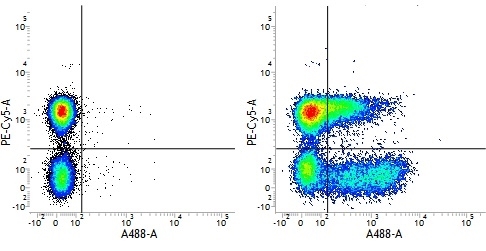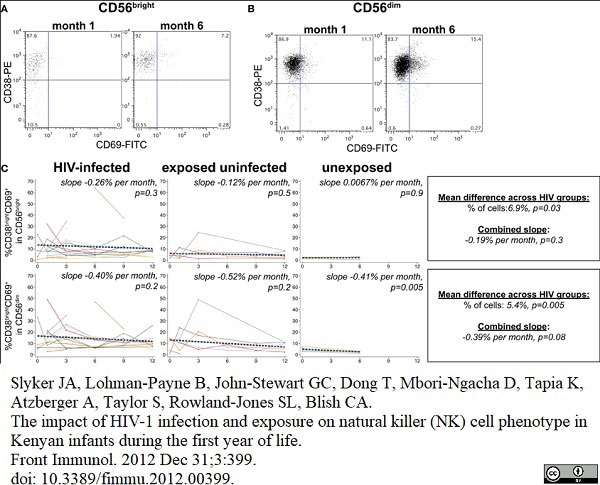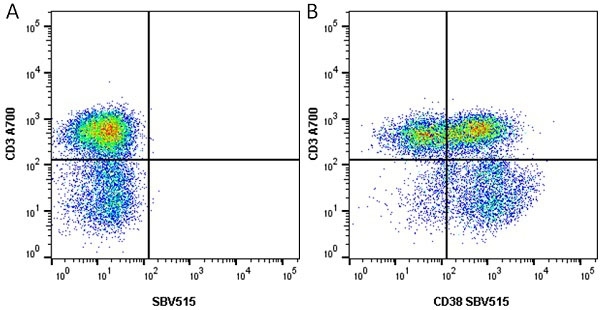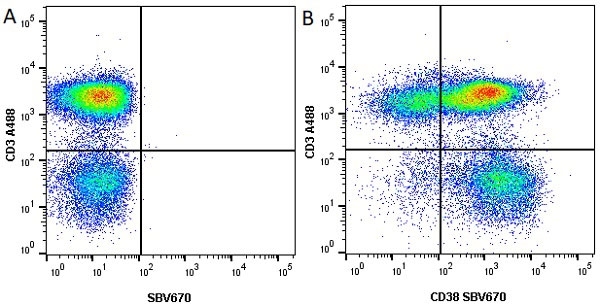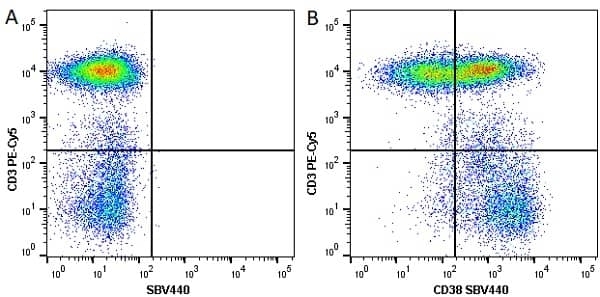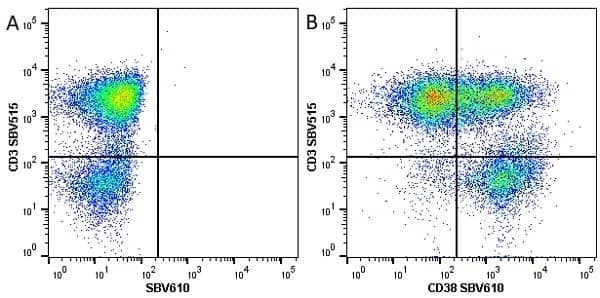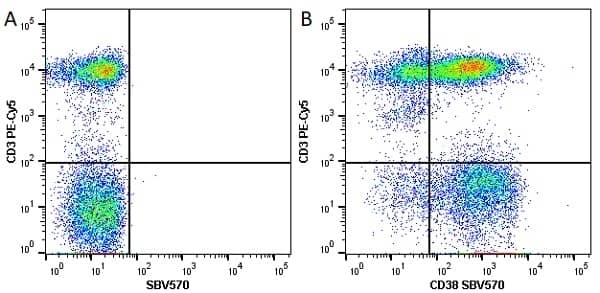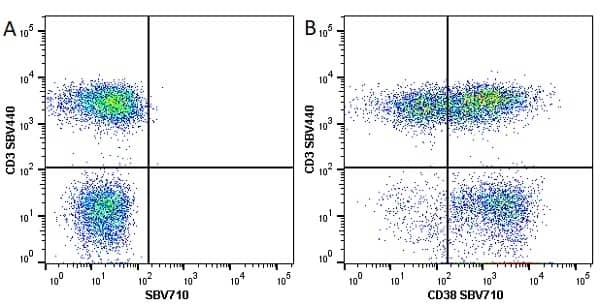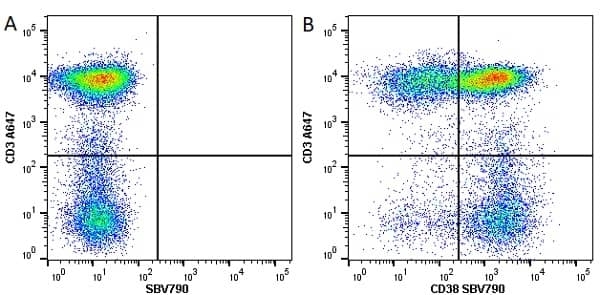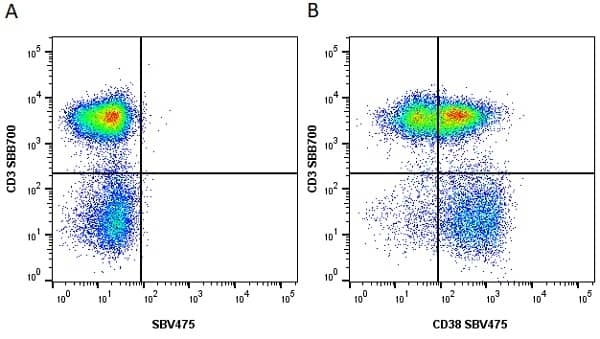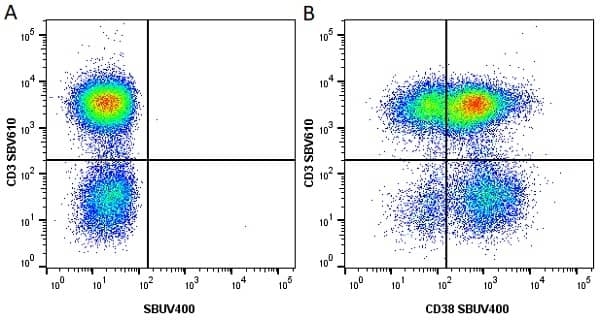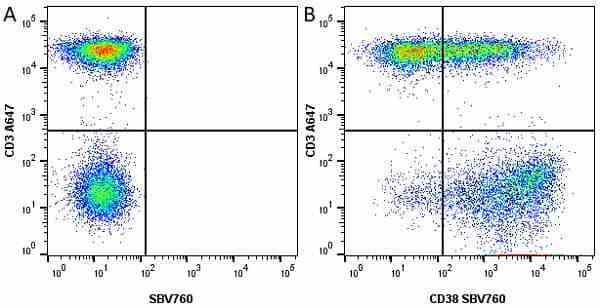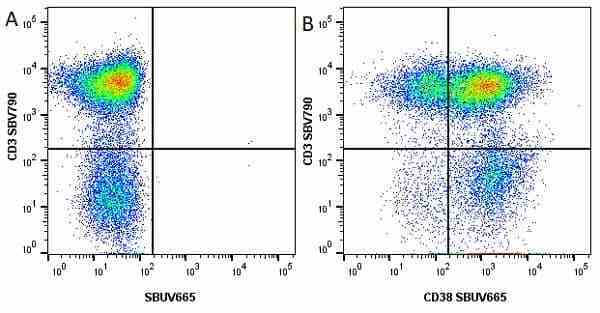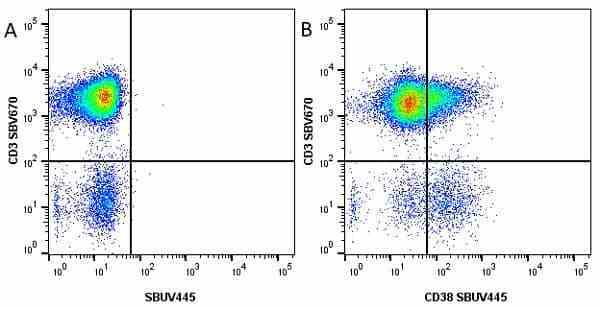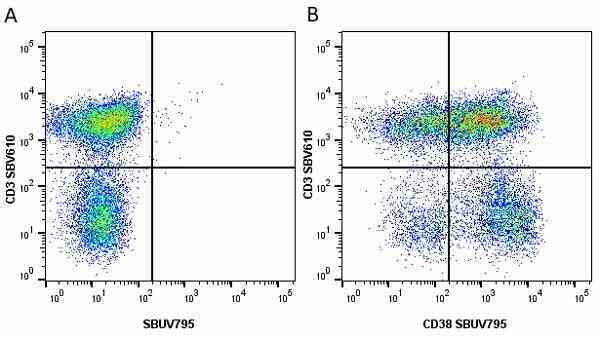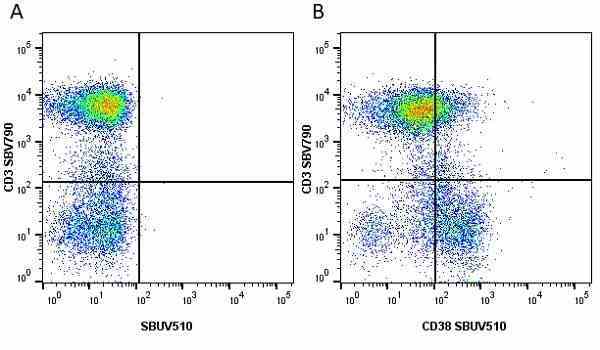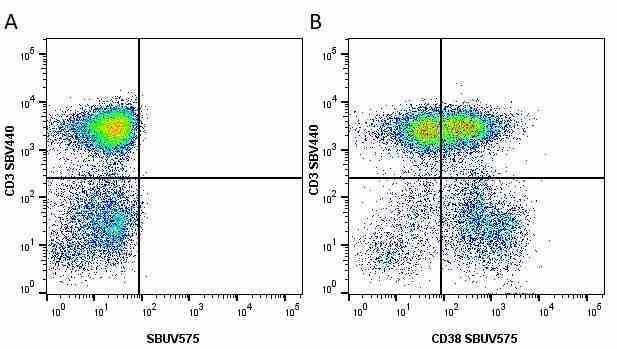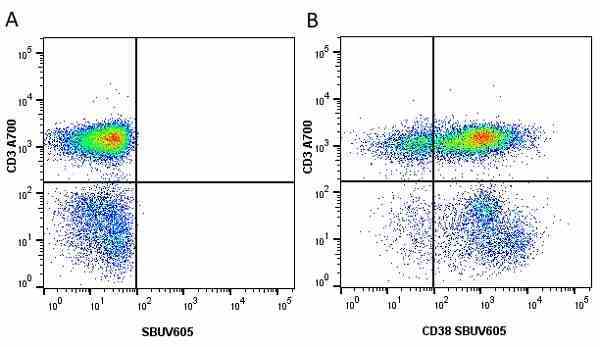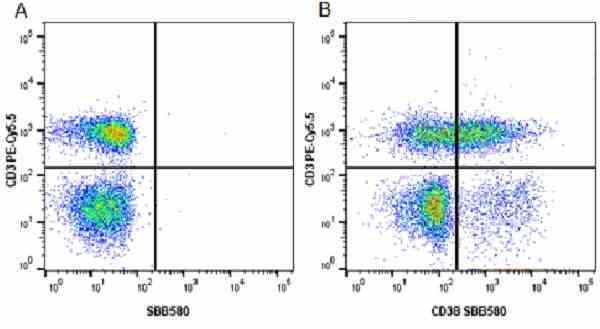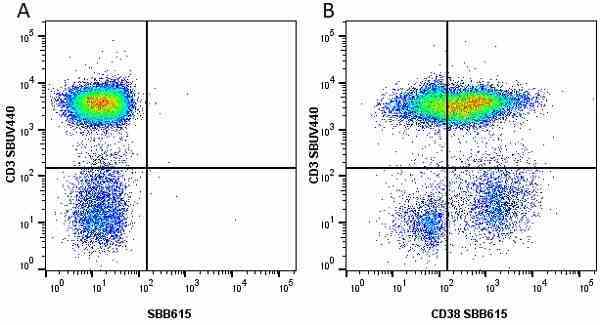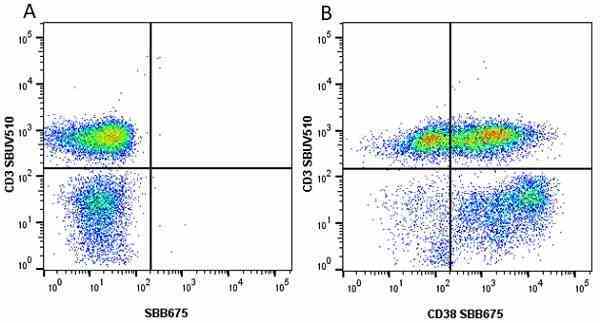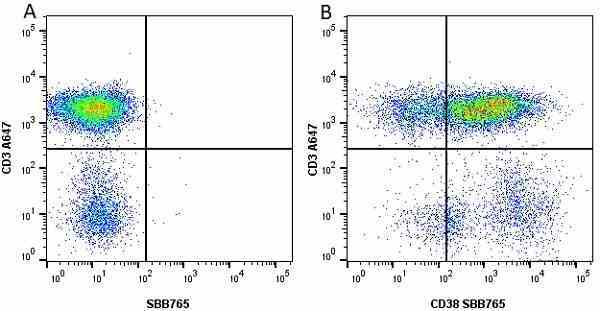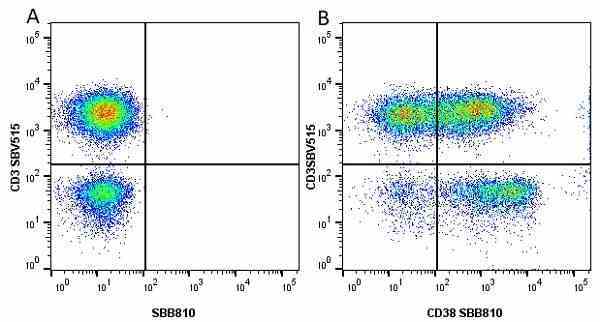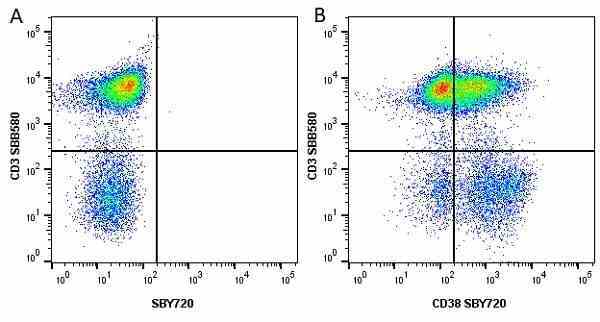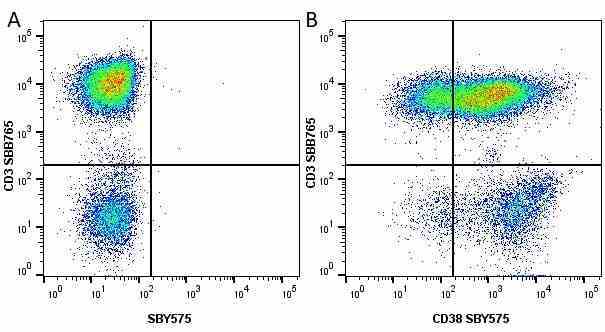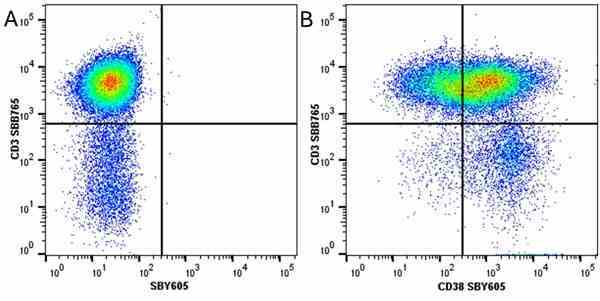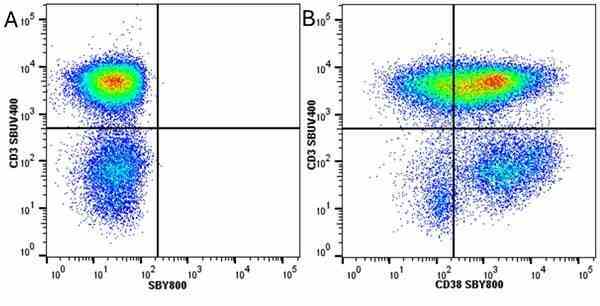CD38 antibody | AT13/5



























Mouse anti Human CD38
- Product Type
- Monoclonal Antibody
- Clone
- AT13/5
- Isotype
- IgG1
- Specificity
- CD38
| Mouse anti Human CD38 antibody, clone AT13/5 recognizes CD38, also known as ADP-ribosyl cyclase/cyclic ADP-ribose hydrolase 1, 2'-phospho-ADP-ribosyl cyclase, 2'-phospho-ADP-ribosyl cyclase, ADP-ribosyl cyclase 1, Cyclic ADP-ribose hydrolase 1 or T10. CD38 is a 300 amino acid ~45 kDa single pass type II transmembrane glycoprotein and Mouse anti Human CD38 antibody, clone AT13/5 has a reactivity pattern consistent with other antibodies of the CD38 cluster. CD38 is expressed by plasma cells, monocytes, early lymphoid cells and activated T cells. CD38 is widely used to study the processes of B and T differentiation and activation. CD38 is a multifunctional enzyme involved in calcium signaling and nicotinamide adenine dinucleotide (NAD+) metabolism (de Oliveira et al. 2018). |
- Target Species
- Human
- Product Form
- Purified IgG - liquid
- Preparation
- Purified IgG prepared by affinity chromatography on Protein A from tissue culture supernatant
- Buffer Solution
- TRIS buffered saline
- Preservative Stabilisers
- <0.1% sodium azide (NaN3)
- Immunogen
- Namalwa human B-cell line.
- Approx. Protein Concentrations
- IgG concentration 1 mg/ml
- Fusion Partners
- Spleen cells from immunized BALB/c mice were fused with cells of the mouse NS1 myeloma cell line.
- Regulatory
- For research purposes only
- Guarantee
- 12 months from date of despatch
Avoid repeated freezing and thawing as this may denature the antibody. Storage in frost-free freezers is not recommended.
| Application Name | Verified | Min Dilution | Max Dilution |
|---|---|---|---|
| Flow Cytometry | 1/100 | ||
| Immunohistology - Frozen 1 | |||
| Immunohistology - Paraffin | |||
| Immunoprecipitation |
- 1The epitope recognised by this antibody is reported to be sensitive to formaldehyde fixation and tissue processing. Bio-Rad recommends the use of acetone fixation for frozen sections.
- Flow Cytometry
- Use 10μl of the suggested working dilution to label 106 cells in 100μl
| Description | Product Code | Applications | Pack Size | List Price | Your Price | Quantity | |
|---|---|---|---|---|---|---|---|
| Mouse IgG1 Negative Control | MCA928 | F | 100 Tests |
|
Log in | ||
| List Price | Your Price | ||||||
|
|
Log in | ||||||
| Description | Mouse IgG1 Negative Control | ||||||
Source Reference
-
Ellis, J.H. et al. (1995) Engineered anti-CD38 monoclonal antibodies for immunotherapy of multiple myeloma.
J Immunol. 155 (2): 925-37.
References for CD38 antibody
-
Corcione, A. et al. (2009) CX3CR1 is expressed by human B lymphocytes and mediates [corrected] CX3CL1 driven chemotaxis of tonsil centrocytes.
PLoS One. 4: e8485. -
Hovden, A.O. et al. (2011) Maturation of monocyte derived dendritic cells with OK432 boosts IL-12p70 secretion and conveys strong T-cell responses.
BMC Immunol. 12: 2. -
Tipping, A.J. et al. (2009) High GATA-2 expression inhibits human hematopoietic stem and progenitor cell function by effects on cell cycle
Blood. 113: 2661-72. -
Slyker, J.A. et al. (2012) Acute cytomegalovirus infection is associated with increased frequencies of activated and apoptosis-vulnerable T cells in HIV-1-infected infants.
J Virol. 86 (20): 11373-9. -
Slyker, J.A. et al. (2012) The impact of HIV-1 infection and exposure on natural killer (NK) cell phenotype in Kenyan infants during the first year of life.
Front Immunol. 3: 399. -
Kelleher, M. et al. (2011) Comparative Kinetics of Immune Responses and Changes in Cellular Sub-Sets Detected in Colorectal Cancer Patients Vaccinated with MVA-5T4 (TroVax) Administered Alongside Two Different Chemotherapy Regimens
J Cancer Therapy. 02 (01): 54-64.
Further Reading
-
Malavasi, F. et al. (1994) Human CD38: a glycoprotein in search of a function.
Immunol Today. 15 (3): 95-7.
- RRID
- AB_321678
- UniProt
- P28907
- Entrez Gene
- CD38
- GO Terms
- GO:0005886 plasma membrane
- GO:0003953 NAD+ nucleosidase activity
- GO:0016021 integral to membrane
- GO:0004872 receptor activity
- GO:0005488 binding
- GO:0008624 induction of apoptosis by extracellular signals
- GO:0042493 response to drug
- GO:0016563 transcription activator activity
- GO:0016564 transcription repressor activity
- View More GO Terms
- GO:0030890 positive regulation of B cell proliferation
- GO:0043066 negative regulation of apoptosis
- GO:0050853 B cell receptor signaling pathway
MCA1019T
MCA1019
If you cannot find the batch/lot you are looking for please contact our technical support team for assistance.
Please Note: All Products are "FOR RESEARCH PURPOSES ONLY"
View all Anti-Human ProductsAlways be the first to know.
When we launch new products and resources to help you achieve more in the lab.
Yes, sign me up